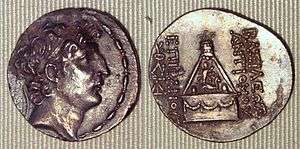Antiochus VIII Grypus
| Antiochus VIII Epiphanes | |
|---|---|
| Antiochus VIII Callinicus/Philometor | |
|
Coin of Cleopatra Thea and Antiochus VIII | |
| King of the Seleucid Empire (King of Syria) | |
| Reign |
125–121/123 BC (as co-regent with his mother Cleopatra Thea) 121/123 BC–96 BC (in opposition to his half-brother/cousin Antiochus IX Cyzicenus) |
| Coronation | 125 BC |
| Predecessor | Cleopatra Thea and Seleucus V Philometor |
| Successor | Seleucus VI Epiphanes |
| Born | Unknown |
| Died | 96 BC |
| Spouse |
Tryphaena Cleopatra Selene I |
| Dynasty | Seleucid |
| Father | Demetrius II Nicator |
| Mother | Cleopatra Thea |
Antiochus VIII Epiphanes/Callinicus/Philometor, nicknamed Grypus (hook-nose), was crowned as ruler of the Greek Seleucid kingdom in 125 BC. He was the son of Demetrius II Nicator and Cleopatra Thea.
Biography
Childhood
Either he or his half brother Antiochus IX Cyzicenus is probably identical with the ephemeral child ruler Antiochus Epiphanes, who was crowned by Cleopatra Thea after the death of Antiochus VII but before Demetrius II returned to Antioch. The child Antiochus Epiphanes, who is known from coins, was deposed—but not killed—when Demetrius II was restored in 129 BC.
Rise to power
Antiochus Grypus was crowned as a teenager in 125 BC after his mother Cleopatra Thea had killed his elder brother Seleucus V Philometor, ruling jointly with her and he defeated usurper Alexander II Zabinas in 123 BC. In 121 BC, Antiochus decided to rid himself of his influential mother.[1] According to Justin, his mother tried to poison him with wine, but the suspicious king forced her to drink the cup herself.[2] However, it was Grypus himself who would became famous for his interest in toxicology.[1][3] Some poems about poisonous herbs believed to have been written by him are quoted by the famous physician Galen.
Reign as King of Syria
Despite political shortcomings, Grypus was a popular king. His ugly, lazy appearance on coins (common among the last Seleucids), together with stories of his lavish banquets, made posterity believe his dynasty was degenerate and decadent. This was, however, a conscious image invoking the Hellenistic concept of Tryphe - meaning good life, which the last Seleucids strove to be associated with, as opposed to the exhausting civil wars and feuds which troubled their reigns in reality.[4]
A story of his luxurious parties claims he sent food home with guests who attended banquets, complete with a camel as beast of burden, as well as an attendant to carry the guest himself. This should certainly have caused some strain on the already depleted treasury.[5]
Civil War
In 116 BC his half-brother and cousin Antiochus IX Cyzicenus returned from exile and a civil war began. Cyzicenus' wife, also named Cleopatra, was a sister of Tryphaena and was eventually killed in a dramatic fashion in the temple of Daphne outside Antioch, on the order of Tryphaena. Cyzicenus eventually killed Tryphaena as revenge. The two brothers then divided Syria between them until Grypus was killed by his minister Heracleon in 96 BC.
Family
He married the Ptolemaic princess Tryphaena ca. 125[1], and had six children by her:
- Seleucus VI Epiphanes
- Antiochus XI Ephiphanes Philadelphus
- Philip I Philadelphus
- Demetrius III Eucaerus
- Antiochus XII Dionysus
- Laodice VII Thea, married to king Mithridates I Callinicus of Commagene as part of a settlement by Mithridates' father Sames II Theosebes Dikaios to ensure peace between the Kingdom of Commagene and the Seleucid Empire. Laodice and Mithridates' son was King Antiochus I Theos of Commagene, grandson to Grypus.
In 102, Cleopatra III of Egypt gave him her daughter Cleopatra Selene I in marriage, but she gave him no children. Afterwards, she went to marry Antiochus IX Cyzicenus.[1]
See also
References
- 1 2 3 4 Ogden, Daniel (1999). Polygamy Prostitutes and Death. The Hellenistic Dynasties. London: Gerald Duckworth & Co. Ltd. p. 150. ISBN 07156 29301.
- ↑ Justin. "39.2.7-8". Epitome of Pompeius Trogus' Philippic Histories.
- ↑ Galen, 14 p. 185
- ↑ Bilde, Per (1996). Aspects of Hellenistic Kingship. Studies in Hellenistic civilization. 7. Aarhus University Press. p. 36. ISBN 978-8-772-88474-5. ISSN 0906-3463.
- ↑ Smith, Andrew. "Athenaeus: Deipnosophists - Book 5 (c)". www.attalus.org.
External links
| Wikimedia Commons has media related to Antiochus VIII Grypus. |
- Antiochus VIII Grypus entry in historical sourcebook by Mahlon H. Smith
Antiochus VIII Grypus Born: Unknown Died: 96 BC | ||
| Preceded by Cleopatra Thea |
Seleucid King (King of Syria) 125–96 BC with Cleopatra Thea (126–121/3 BC) |
Succeeded by Antiochus IX Cyzicenus |
